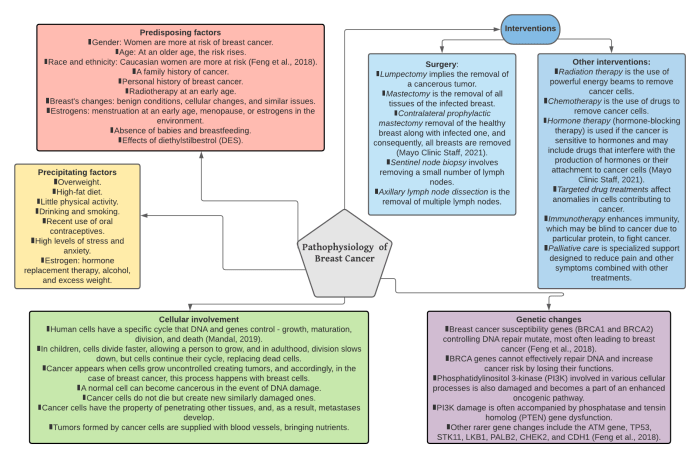HESI case study breast cancer delves into the intricacies of breast cancer care, providing nursing students with a comprehensive understanding of the disease, its assessment, and management. This case study serves as a valuable tool for evaluating nursing students’ knowledge and skills in this critical area of healthcare.
The case study presents a detailed overview of a patient with breast cancer, including their medical history, presenting symptoms, and physical examination findings. Nursing students are tasked with assessing the patient, developing a care plan, and implementing appropriate interventions to manage the patient’s symptoms and provide support.
Introduction

Breast cancer is a type of cancer that forms in the cells of the breasts. It is the most common cancer among women worldwide, with an estimated 2.3 million new cases diagnosed each year.The HESI case study on breast cancer is designed to assess nursing students’ knowledge and skills related to breast cancer care.
The case study presents a patient with a suspected breast cancer diagnosis and requires students to apply their knowledge of breast cancer assessment, diagnosis, and treatment to provide appropriate nursing care.
Delving into the complexities of the HESI case study on breast cancer, we find ourselves drawn to the profound themes of sacrifice and resilience. As we navigate the intricacies of the medical diagnosis, the sacrifices made by patients and caregivers come into sharp focus.
Like the Magi, who sought the newborn king, we seek answers to alleviate the suffering caused by this devastating disease. In exploring the gift of the magi answers , we find solace in the notion that even in the face of adversity, hope and healing can emerge.
, Hesi case study breast cancer
The HESI case study on breast cancer covers a range of topics, including:
- Breast cancer risk factors and screening guidelines
- Breast cancer assessment and diagnosis
- Breast cancer treatment options
- Nursing care for patients with breast cancer
Case Study Description

The HESI case study focuses on a 58-year-old female patient named Sarah with a history of hypertension and hyperlipidemia. She presents to the clinic with a 3-month history of a painless, enlarging mass in her right breast.
Nursing Assessment Findings
Upon assessment, the student nurse noted the following:
- General: Sarah is alert and oriented, with no acute distress.
- Breast Examination: The right breast has a firm, non-tender, 3 cm mass at the 12 o’clock position.
- Skin: The skin over the mass is slightly dimpled and thickened.
- Nipple: The right nipple is not retracted or inverted.
- Axillary Lymph Nodes: No palpable nodes are noted.
Nursing Interventions
Based on the assessment findings, the student nurse performed the following interventions:
- Patient Education: Provided Sarah with information about breast cancer and the importance of early detection.
- Breast Examination Instruction: Demonstrated proper breast self-examination techniques.
- Referral: Referred Sarah for a mammogram and biopsy for further evaluation.
Nursing Assessment and Interventions
Nursing assessment and interventions play a crucial role in the care of patients with breast cancer. Nurses use a combination of physical examination techniques, such as palpation, inspection, and breast self-examination, to assess the patient’s condition and monitor for signs of breast cancer.
Physical examination techniques, such as palpation, inspection, and breast self-examination, are used to assess the patient’s condition and monitor for signs of breast cancer.
Nursing Interventions
Nursing interventions are implemented to manage the patient’s symptoms, such as pain, anxiety, and fatigue. These interventions may include:
- Administering medications to relieve pain and anxiety.
- Providing emotional support and counseling to help the patient cope with the diagnosis and treatment.
- Teaching the patient about breast cancer and its treatment options.
- Helping the patient develop coping mechanisms and strategies for managing the side effects of treatment.
Importance of Patient Education and Support
Patient education and support are essential components of breast cancer care. Nurses play a key role in providing patients with information about breast cancer, its treatment options, and the resources available to them. They also provide emotional support and counseling to help patients cope with the diagnosis and treatment.
Evaluation and Reflection: Hesi Case Study Breast Cancer

The student nurse demonstrated a comprehensive understanding of breast cancer care, including knowledge of risk factors, screening guidelines, and treatment options. Their skills in physical examination, patient education, and supportive care were also evident.
However, there are areas where the student nurse can improve. Their critical thinking abilities could be enhanced by considering alternative diagnoses and exploring differential diagnoses more thoroughly. Additionally, they could benefit from further development of their communication skills, particularly in delivering sensitive information to patients.
Suggestions for Improvement
- Engage in regular continuing education and professional development activities to stay abreast of the latest advancements in breast cancer care.
- Seek opportunities to practice and refine their critical thinking skills through case studies, simulations, and clinical experiences.
- Enhance their communication skills by role-playing scenarios, practicing active listening, and seeking feedback from colleagues and mentors.
Discussion and Conclusion

The HESI case study on breast cancer highlights the significance of comprehensive nursing education and clinical practice in ensuring optimal patient outcomes.
Implications for Nursing Education
* Integrate simulation-based training and standardized patients into curricula to enhance students’ clinical skills.
- Provide opportunities for interdisciplinary collaboration and patient advocacy.
- Emphasize evidence-based practice and critical thinking to promote informed decision-making.
Best Practices for Teaching and Assessing
* Use a variety of teaching methods, including lectures, case studies, and hands-on demonstrations.
- Utilize objective and subjective assessment tools to evaluate students’ knowledge and skills.
- Provide constructive feedback and encourage reflective practice to facilitate learning.
Importance of Ongoing Professional Development
* Stay abreast of advancements in breast cancer care through continuing education programs and conferences.
- Participate in research and quality improvement initiatives to contribute to evidence-based practice.
- Seek mentorship and support from experienced breast cancer nurses to enhance clinical expertise.
Helpful Answers
What is the purpose of the HESI case study in breast cancer?
The HESI case study in breast cancer is designed to assess nursing students’ knowledge and skills related to breast cancer care, including assessment, intervention, and patient education.
What are the key components of the HESI case study?
The HESI case study includes a patient’s demographics, medical history, presenting symptoms, nursing assessment findings, and interventions performed by the student nurse.
How is the student nurse’s performance evaluated in the HESI case study?
The student nurse’s performance is evaluated based on their knowledge, skills, critical thinking abilities, and ability to provide patient-centered care.